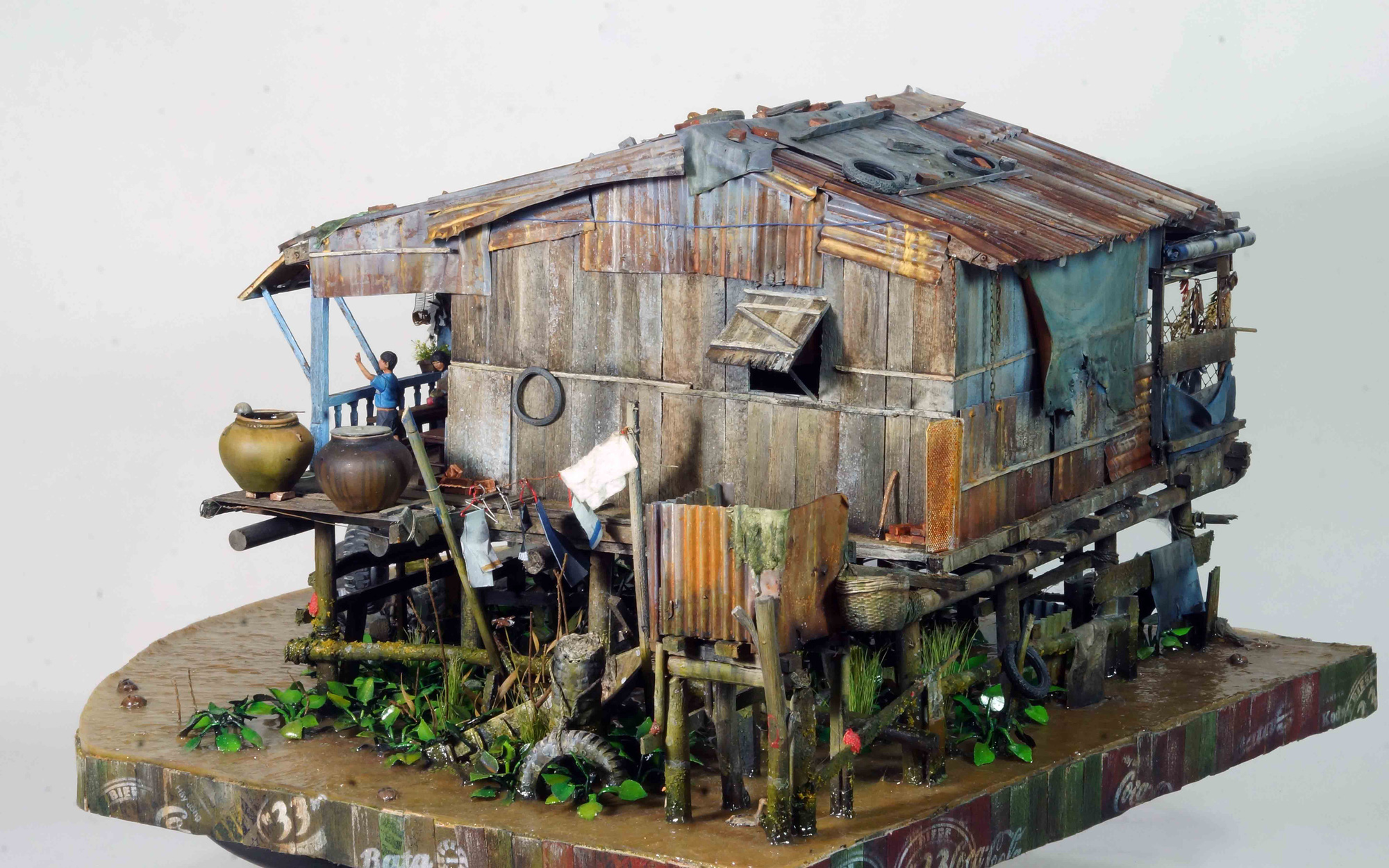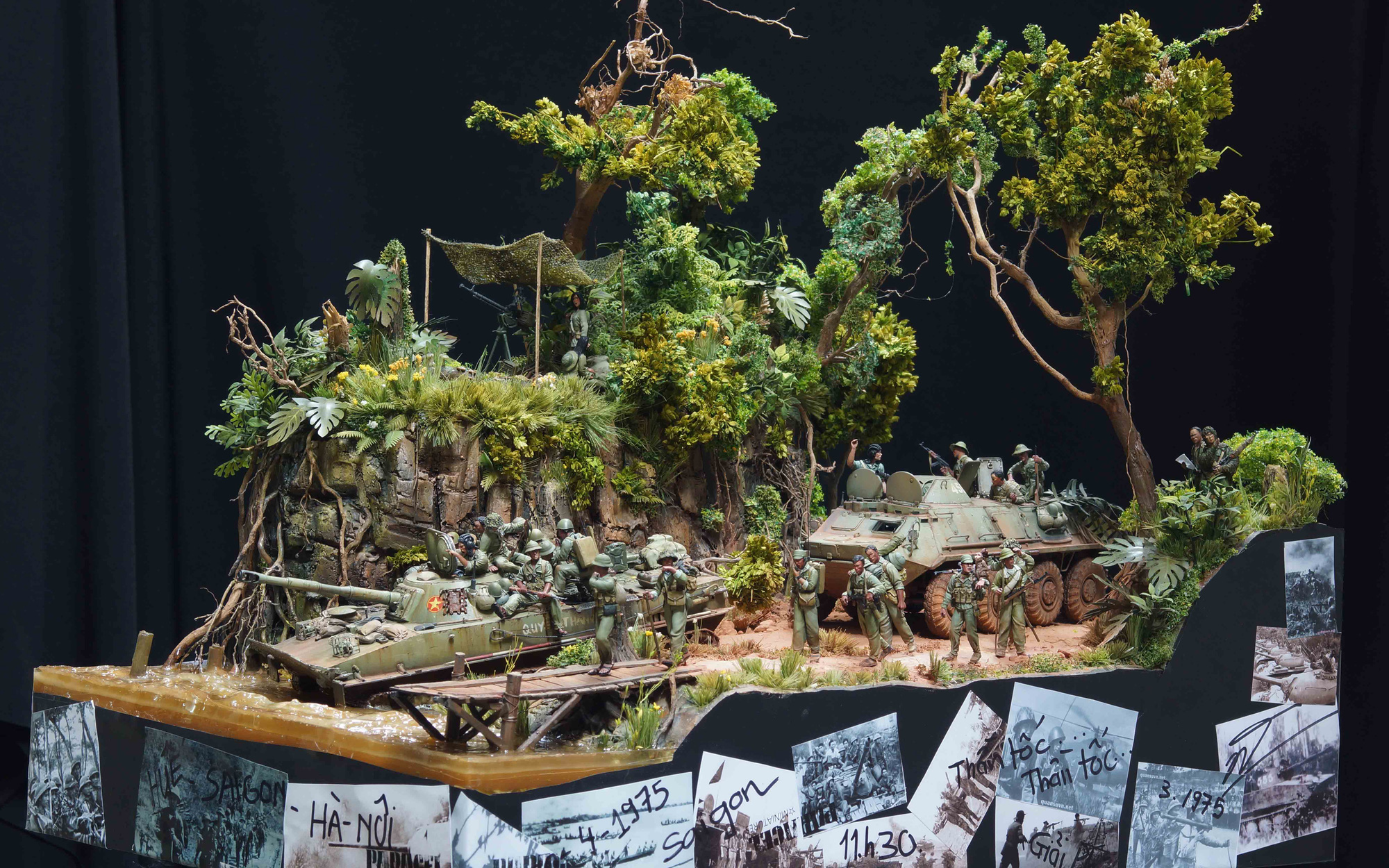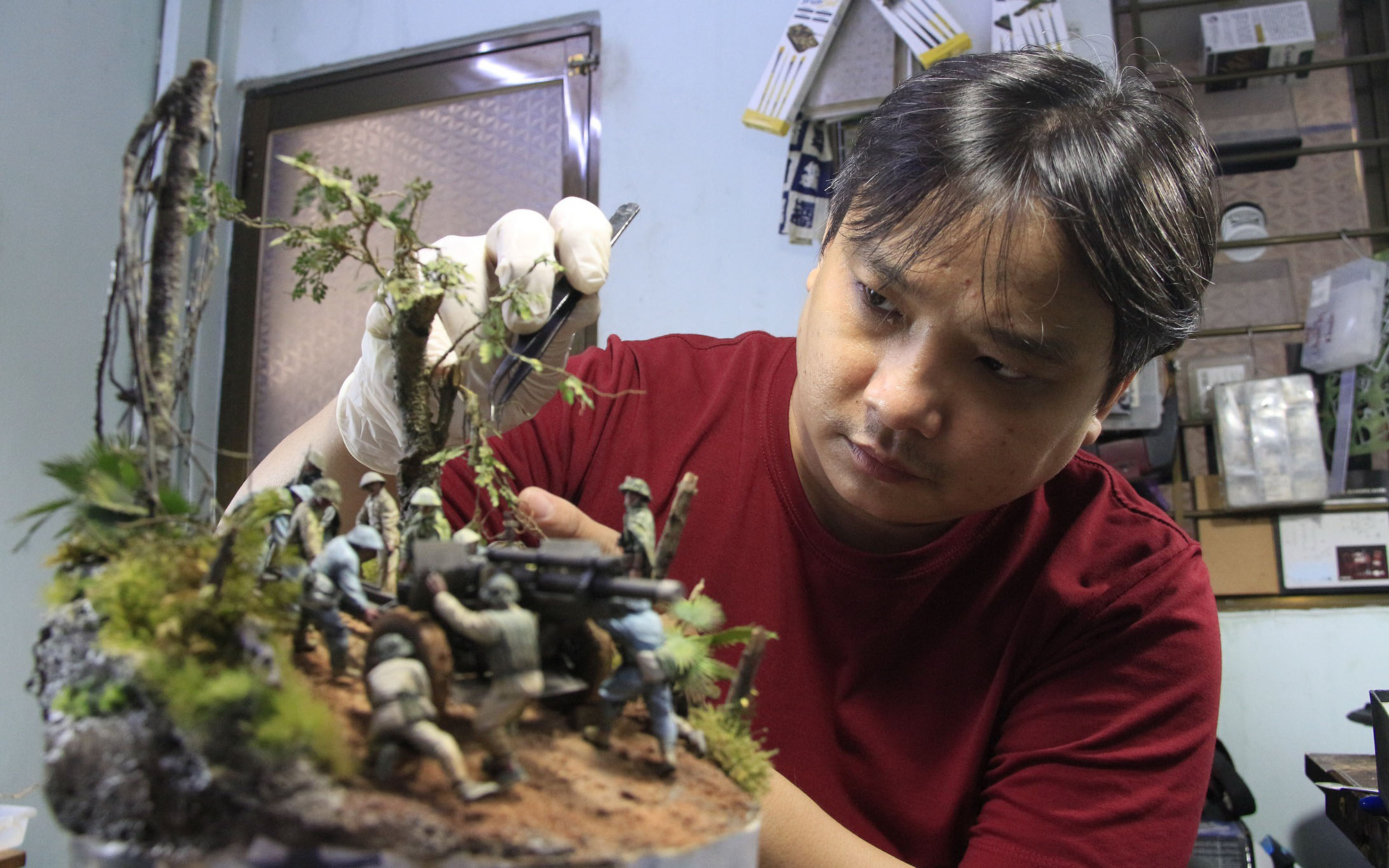To the 35-year-old artist Le Xuan Giang, scale models are more than a creative outlet serving his passion for history; they are a way of life.
An inventory of military arms, downsized
Inside Giang’s tiny apartment on Van Kiep Street of Binh Thanh District, Ho Chi Minh City, one cannot help but be overwhelmed by the dozens of war maneuvers displayed by the thousands of miniature models covering the apartment.
The apartment appears to be an arsenal of mini tanks, armored vehicles, artillery, and AK-47 and AK-74 assault rifles.
Other scale models of Giang leans more towards a scenic approach: one depicts a troop of hundreds charging into a skirmish, while another shows a mother sending his son off to war, wrapping the emblematic checkered scarf around his neck while tucking a handful of food in his backpack.
This collection has been Le Xuan Giang’s work for the past ten years. Prior, he had focused on oil painting.
Giang graduated from Ho Chi Minh City’s University of Fine Arts in 2009 with certain ponderings on the limit of the canvas and paint — a serious hindrance to his artistic vision at the time.
While browsing a bookstore in early 2010, he spotted some military scale models on the shelf and was immediately spellbound.
The longer he looked, the more he realized the potential to elevate this medium into works of art with depth, dimensions, and storytelling.
“It’s like finding a way out of the thought impasse that had haunted me for a while. I brought a tank model home and it gradually became a part of my life,” Giang explained.
Scale models are a miniature representation of a real-life object at a certain scale. They can be related to architecture, interior design, the military, and everyday life.
Giang’s models primarily focus on the Vietnamese military.
According to Giang, working with scale models feels like entering another world — a realm of playful, intuitive art.
In order to keep the sophisticated details of each model, Giang has calcified his ten years of experience into a simple code: no room for half-heartedness or cutting corners.
Aside from understating art, architecture, space design, mechanics and chemistry, artists who work with models must comprehend the historical and political periods they work with to ensure the accuracy of their projects.
 |
| 'Nha tren song' (House on the river), a scale model by Vietnamese artist Le Xuan Giang that won the gold medal at a fair in Malaysia, is seen in a photo provided by Giang. |
Paracel — an aspiring international project
According to Giang, there are at least five steps in building a miniature soldier: First, a skeletal framework needs to be shaped with metal wire to form the desired posture.
Next, clay must be applied to the metal frame to mold the torso, limbs, and facial details for the character. This is considered the most challenging and strenuous step even for adept artists at Giang’s level.
The fact that these figures are downscaled means that there is a substantial degree of focus required from the artists in order to pull off the facial expression and manner of each character.
Coloring is the final stage, also considered the phase that makes or breaks the figure. Giang said he has had to recolor and even discard countless miniatures due to imperfections made during this step.
“Each figure wears a different color palette depending on the historical period that we are working on. Inaccuracy in color mixing is not accepted, even at the slightest level,” Giang said.
Apart from his historical projects, Giang also creates models of floating markets and floating households in Vietnam’s Mekong Delta using his experience as a native of Vinh Long — a Mekong Delta province.
Returning from his day job as a graphic design lecturer at Ho Chi Minh City-based Hoa Sen University, Giang uses his work with scale models as a means to alleviate his daily stress.
But for Giang, scales models are more than just a hobby. Since beginning his journey with scale models he’s founded Paracel, a brand specializing in creating scale models of soldiers and weapons for foreign markets.
The brand — whose name is inspired by the English name for Hoang Sa, a group of islands administered by Vietnam in the East Vietnam Sea — started humble, only being known by some of Giang’s fellow miniature enthusiasts, but has since grown significantly through partnerships with firms from Japan, Spain, Germany, and other foreign countries.
All his exported products are assembled according to Giang’s high standards.
“I want to incorporate a message that came from the depth of my self-reflection in these exported products. By naming the brand ‘Paracel’ for a bona fide Vietnamese product, I hope my message came through,” Giang confessed.
‘Painting’ history with scale models
Giang meticulously shapes every limb, shirt, shoe, facial feature, and expression of each Vietnamese soldier figurine he creates, including those in his scale model depicting the extraordinary feat of pulling canons uphill at Dien Bien Phu in 1945.
He had initially scheduled the model to be done in time for the 66-year anniversary of the Battle of Dien Bien Phu — which marked a divisive victory of Vietnam over French invaders in the Indochina War— earlier this year, but failed to meet the deadline due to his dedication to perfection.
Through Giang’s interpretation, every detail of the scale models comes alive with their own flair and expression. Even subordinate details from the branches to blades of grass are designed with perfection in mind.
Giang utilizes a wide range of materials in his products, including recycled goods such as plastic bottles and discarded car tires.
On top of his Dien Bien Phu project, Giang also prides himself in recreating a snapshot of other historical events, one of which is the all-out offensive and uprising in the spring of 1975 that brought about peace and reunification in Vietnam.
 |
| 'Tu mien nui xuong dong bang' (From the mountain to the plateau), a scale model by Vietnamese artist Le Xuan Giang, is seen in a photo provided by Giang. |
A standalone exhibition
Giang’s art work ‘Tu mien nui xuong dong bang’ (From the mountain to the plateau) depicting the offensive was actually made by commission for a Japanese magazine.
His work ‘Cho noi Viet Nam’ (Vietnam’s floating market) has also gained international attention, winning a silver medal at a scale model competition in Taiwan.
Two of his other works ‘Dai bang ha canh’ (Landing eagle) and ‘Nha tren song’ (House on the river) won him the gold medal at a scale model fair in Malaysia.
After these awards, a long line of enthusiasts reached out and asked to buy his works with handsome offers.
Nevertheless, Giang turned them all down, instead choosing to save his work for an exhibition of his own in the future.
“[The buyers] said they would lend the works for the exhibition even after I sell to them, but I did not agree. Money can be made your whole life, but scale models can’t,” he stated.
Like us on Facebook or follow us on Twitter to get the latest news about Vietnam!


















































